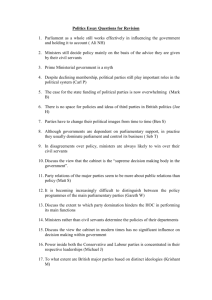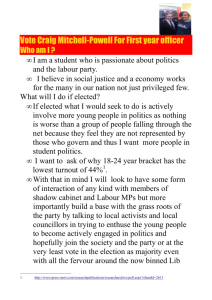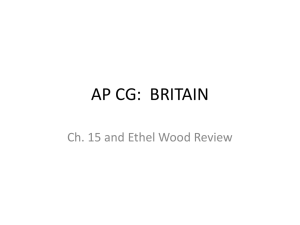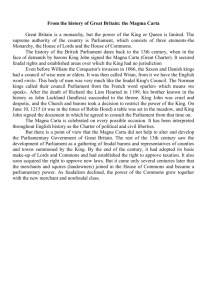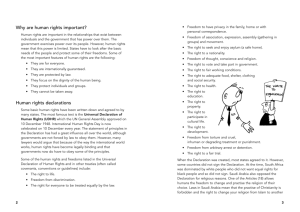GREAT BRITAIN PowerPoint(Caroddo)
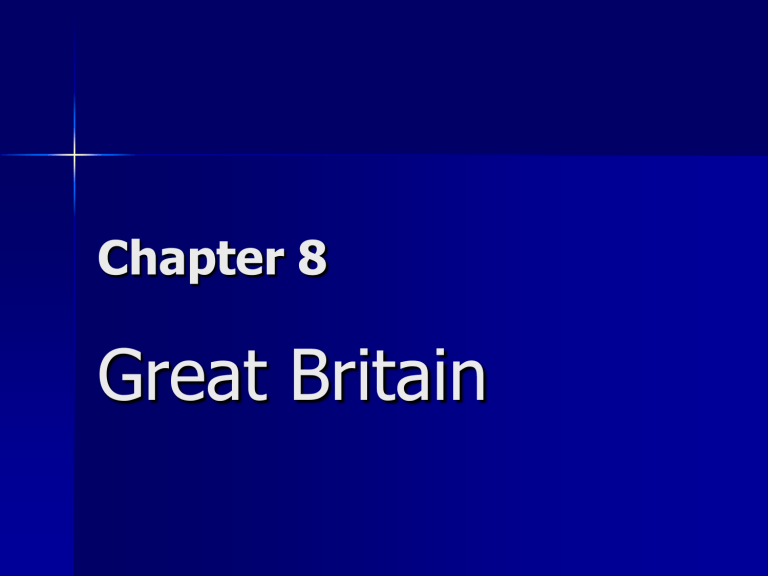
Chapter 8
Great Britain
Legitimacy
The government of Great Britain has developed gradually, so that tradition is a primary source of stability
Great Britain’s constitution is unwritten having evolved from different documents, common law, legal codes, and customs often referred to collectively as the “Constitution of the Crown”
(Constitutional Monarchy)
Magna Carta and the Bill of Rights are central documents in the formation of the British
“constitution”
Historical Evolution of
British Politics
Magna Carta(1215) – King John agreed to consult the nobles before he made important decisions, in particular regarding taxes
Limited government – restrictions on the monarch began with the Magna
Carta
Historical Evolution of
British Politics Part II
English Civil War (1640s) – civil war between the supporters of King Charles I and Parliament
(Roundheads).
Roundheads won, Charles I is executed
Oliver Cromwell leads during this time until
Parliament reinstates the monarch (Charles II)
The Glorious Revolution (1688) – officially established Parliament as the ruling body of Great
Britain. The agreement signed between William &
Mary and Parliament was known as the Bill of
Rights
Historical Evolution of
British Politics Part III
Industrial Revolution
– Great Britain evolves from feudal society to one dominated by colonial mercantilism
– Imperialism
– Trade
Political Culture
Geography
Island
Small in size
No major geographical barriers
Temperate climate
Short supply of fertile soil
Political Beliefs & Values
Through 1960s British political culture characterized by:
– Trust
– Deference to authority and competence
– Pragmatism
– Harmony
– High voter participation
Political Beliefs & Values continued: “Politics of
Protest”
1970s and beyond: Altered views
– Less supportive of collective consensus
– Support for free market economy
– Decreasing support for labor unions
– Increased violence in Northern Ireland
– Thatcherism
– New Labour (Third Way)
Political Culture Part II
Insularity
Feeling of separation, in particular from the continent of Europe
Sense of exceptionalism
Has created friction with the EU
Different from isolationism
Political Culture Part III
Noblesse Oblige
Important tradition in British politics
The duty of the upper classes to take responsibility for the welfare of the lower classes
Legacy of feudal times (Lords protected serfs)
Reflected in willingness of British citizens to accept a welfare state
Margaret Thatcher’s administration challenged this by significantly cutting social services and social welfare programs
Political Culture Part IV:
Multi-nationalism
Although Britain has a relatively large amount of cultural homogeneity
(Anglo/white) it is divided into four nations
– England
– Scotland
– Wales
– Northern Ireland
Political Culture Part V:
Extension of Voting Rights
Great Reform Act of 1832: About 300,000 men gained right to vote, House of Commons gained more power in relation to House of Lords
Reform Act of 1867: electorate reaches 3 million, many working class people allowed to vote
Representation of the People Act of 1884: electorate is further expanded to make sure that majority of electorate is working class
Women’s Suffrage: all women over the age of 28 and all men over 21 granted the right to vote in
1918. By 1928, all women over 21 allowed to vote.
Collective Consensus
Began during WWII with Churchill’s emphasis on putting class differences aside in order to work together to defeat Germany
Churchill headed an all-party coalition government during WWII (He was originally elected as a
Conservative)
The spirit of collective consensus continued beyond the war well into the 1960s.
Both Labour and Conservative parties supported the development of the modern welfare system
Beveridge Report – adopted by both parties during the war made all citizens eligible for health, unemployment, pension, and other welfare benefits
National Health Service (1948) – created under the leadership of the Labour Party
England
Largest region of Great Britain
Makes up 2/3 of the land mass
English have dominated the other nationalities historically, and still hold a disproportionate share of political power
Scotland
History of resistance to English rule
Strong sense of national identity
Have their own flag
Recently granted their own parliament and regional assembly (devolution)
Scottish National Party – political party of the region of Scotland
Wales
Became subject to the King of England in
16 th century
Located west of England
Plaid Cymru – Welch national political party
Strong sense of national pride reflected in their flag and in their own language
Granted their own assembly (devolution)
Northern Ireland
Long history of conflict between England and Ireland, particularly over religion
After the English Civil War, Oliver Cromwell attempted to impose
Protestantism on the mostly Catholic Ireland
After WWI home rule was granted to Ireland except for the northeast corner where Protestants outnumbered Catholics, 60% to
40%
Home rule was granted largely because of the Irish Republican Army
(IRA) which used guerrilla tactics against British forces to secure independence
Sinn Fein – political party of the IRA
In 1949 the bulk of Ireland officially became independent
Northern Ireland remains under British control
Their continues to be a great deal of conflict between Catholics and
Protestants in Northern Ireland
Education & Political Elite
Recruitment
“Public schools” originally were intended to train boys for “public life” in the military, civil service, or politics
Majority of Britain’s political elites go to public boarding schools
Currently only about 65% of British 17-year olds are still in school, the lowest number of any industrialized society
Oxbridge (Oxford-Cambridge) – the most important portal to membership in the elite classes and political recruitment is through these two prestigious universities
Ethnic Minorities
Make up about 8% of the British population
– Indian (23%)
– Pakistani (16%)
– Afro-Caribbean (13%)
– Black African (11%)
Devolution
British government is a unitary system (centralized control)
Starting in the 1970s the Scots and Welsh made an aggressive push for certain political autonomy in their regions
Devolution – the turning over of some political power and autonomy to regional governments
The Labour Party had supported the idea of devolution since the
1970s
Margaret Thatcher’s administration blocked the idea during the period in which they controlled government
Under Tony Blair’s New Labour Party the idea of devolution was revisited
In 1999, referendums in Scotland and Wales successfully passed, and each established their own regional assemblies: powers of taxation, education, and economic planning
In 1998, the Good Friday Agreement established a parliament for
Northern Ireland as well, but it was shut down by London in 2003 when violence broke out once again in the region of Northern
Ireland.
Linkage Institutions
Political Parties
Interest Groups
Media
– Electronic
Labour Party
Largest party on the “left” of political spectrum
Began in 1906 as alliance between trade unions and social groups that were strengthened by expansion of workers’ rights
Traditionally labor union have provided majority of funds for the party
Early history of the party defined by controversial “Clause 4” that called for nationalization of the “commanding heights” of
British industry\
Trade Union Council (TUC) – a coalition of trade unions generally associated with the Labour Party, has traditionally been a force in British politics
Growing moderation of the party reflected by removal of clause in early 1990s
Labour Party in 1990s
Shift in policies toward more centrist views
Shift in political platform originated with Neil
Kinnock, party leader in the 1980s
Moderate-centrist views have continued under leadership of John Smith (1993-94) and Tony Blair (1997-present)
Tony Blair’s adopts “Third Way” platform and creates “New Labour” Party
“Third Way”
Moderate
Centrist alternative to “Old Labour” Party on left and Conservative Party on right
Initiated by Tony Blair in the late 1990s
Attempting to redefine and balance following policy issues:
– Evolving relationship between government & economy
– British relationship with EU
– Balancing act between the United States and European
Union
– Devolution
Conservative Party
Dominant party in Great Britain between WWII and late 1990s
Main party on the right
Traditionally pragmatic as opposed to ideological
Historically has supported a market controlled economy, privatization, and fewer social welfare programs – symbolized by Margaret Thatcher in
1980s
Under Prime Minister John Major (1990-1997) gravitated towards center and away from
Thatcherism
Conservative Party II
Characterized by Noblesse Oblige
Power centered in London
Party organization viewed as elitist
Leadership must submit to annual leadership elections
Weakened by division of party in late 1990s:
– Traditional Wing(one-nation Tories) – values noblesse oblige and elitism, supports Britain’s membership in EU
– Thatcherite Wing – strict conservatives, support full free market, known as “Euroskeptics”, feel EU threatens British sovereignty
Thatcherism
Rightist reforms instituted by Margaret Thatcher in 1980s
– Privatized business and industry
– Cut back on social welfare programs
– Strengthened national defense (staunch anticommunist)
– Got tough with labor unions in response to Labour Parties distinct movement left, which had strengthened labor unions politically
– Returned to market force controls on the economy
– Resisted complete integration into the European Union
– Replaced property tax on houses with a poll tax on individual adults
– Froze income tax increases
– Foreign policy dominated by securing British interests internationally
Liberal-Democratic Party
Alliance between the Liberal and Social Democratic
Parties during the 1980s
Formally merged in 1989 into Liberal Democratic party
Attempted to create strong “in the middle” compromise to the two dominant parties
Won a party high 26% of vote in 1983, but because of single-member district plurality system only secured 23 seats in Parliament
Secured only 62 MP seats in 2005 even though they won 22% of the popular vote
Also managed to gain support in reference to their stance on issues such as health, education, the environment, and the Iraq War
Other Parties
Scottish National Party
Plaid Cymru – Welch nationalist party
Sinn Fein – political arm of the IRA
Democratic Unionist Party – led by
Protestant clergymen
Elections
Members of Parliament (MPs) are the only national officials that British voters select
Elections must be held at least every 5 years, but
Prime Minister may call them earlier
Officially elections occur after the Crown dissolves
Parliament, but that always happens after the Prime
Minister requests it
Power to call elections very important – the
Prime Minister always calls elections when they think that the majority party has the best chance to win
Elections II
“Winner-take-all” system
Single-member district plurality system
Each party selects a candidate to run for each district
“First-past-the-post” winner
MPs do not have to live in the district in which they are running, therefore party selects who runs in what districts
Party leaders run from safe districts – or districts that the party almost always wins
Political neophytes are selected to run in districts the party know it will lose
They are usually happy just to receive more votes than the party usually gets in that district
Voting Patterns
Conservative Party
– Middle and upper classes
– Educated
– Residents of England, mostly rural and suburban areas
Labour Party
– Traditionally supported by working class
– Residents of urban and industrial areas (Manchester,
Liverpool, Newcastle)
– “Third Way” centrist policies have made Labour Party appealing to Scots, Welsh, and the poor
U.S. vs British Elections
United States
– Parties are less powerful
– Members must live in districts
– Party leaders run in their respective districts
– Individual votes for four officials on national level
– Between 30 and 60 percent of the eligible voters actually vote
– First-past-the-post, singlemember districts; virtually no minor parties get representation
Great Britain
– Party determines who runs where
– Members usually don’t live in their districts
– Party leaders run in “safe districts”
– Individual votes for only one official on the national level
– About 70 to 80 percent of the eligible voters actually vote (number was less in
2001 & 2005)
– First-past-the-post, singlemember districts; some representation from minority parties, but still less than if they had proportional representation
Interest Groups
Between 1945-1980, business interests and trade union organizations fiercely competed for influence over the policy-making process
Trade Union Congress (TUC) – represents coalition of unions, had great deal of political power at one time and government often consulted them on important policy decisions – traditionally aligned with Labour Party
Coalition of Business and Industry (CBI) – a coalition of business groups and private interests, usually supportive of the Conservative Party
Media
British newspapers reflect social class divisions
They are divided between quality news and comments that appeal to the middle and upper classes, and mass circulation tabloids that target working and lower classes
British Broadcasting Corporation (BBC)
– Sought to educate citizens
– Usually respectful of government officials
– Had significant clash with Blair government in
2003-2004 over policies regarding the Iraq War
Prime Minister & Cabinet
Prime Minister
– “First among equals”
– Member of Parliament and
Leader of majority party
– Speaks legitimately for all
Members of Parliament
– Chooses cabinet ministers and important subordinate posts
– Makes decisions in cabinet, with agreement of ministers
– Campaigns for and represents the party in parliamentary elections
– Shapes cabinet decisions into policy
Cabinet
– Collective cabinet is the center of policy-making in the British political system
– As leaders of majority party elected by the people, they take
“collective
responsibility” for making the policy of the country
Comparing Executives
Prime Minister of UK
– Serves only as long as he/she remains leader of majority party
– Elected as MP
– Has an excellent chance of getting his/her programs past Parliament
– Cabinet members are always MPs and leaders of the majority party
– Cabinet members not experts in policy areas: rely on bureaucracy to provide expertise
President of the US
– Elected every four years by an electoral college based on popular election
– Elected as president
– Has an excellent chance of ending up in gridlock with
Congress
– Cabinet members usually don’t come from Congress
(although they may)
– Some expertise in policy areas; one criteria for their appointment; head vast bureaucracies
Parliament
House of Commons
Party that receives the majority of the plurality of the votes becomes the Majority
Party in Parliament, the party with the second most votes becomes the “loyal opposition”
House of Commons:
Set-up
House of Commons set-up with long benches facing each other
Prime Minister sits on front bench of majority side, directly in the middle
Directly across from the PM sits the leader of the “opposition” party
Between members of the majority and opposition parties is a long table
Cabinet members sit on the front rows of the majority party side
“Shadow Cabinet” – influential members of the opposition party sit facing Cabinet members of majority party on the opposing side
Backbenchers – less influential members of both parties sit in the rear benches on both sides of the meeting hall as well
House of Commons:
Debate
“Government” – consists of MPs on the first rows of the majority party side, they are majority party members, including the PM, that are most influential in making policy
Question Time/Question Hour – the hour the prime minister and his cabinet must defend themselves from inquisitive attacks from the opposition party as well as direct inquiry from members of his/her own party
Speaker of the House – presides over the debates in
Parliament, the speaker is suppose to be objective and often is not a member of the majority party. Their job is to let all speak without letting the debate get out of hand.
Because of a lack of checks & balances between branches in
British politics the opposition party is seen as the “check” on the majority party within Parliament, this “check” power is best utilized during times of debate over policy
Party Discipline
Party discipline very important in British politics
If party members do not support their party leadership, the “government” may fall into crisis
Vote of Confidence
– Vote on a key issue within the party
– If the issue is not supported, the cabinet by tradition must resign immediately, and new elections for MPs must be held as soon as possible
– This is usually avoided by settling policy differences within majority party membership
– If the party loses a vote of confidence, all MPs lose their jobs, so there is plenty of motivation to vote the party line
Blair’s Vote of Confidence
Higher Education Bill
– Vote of confidence took place in 2005
– Bill squeaked by with an approval vote of 316 to
311
– The bill proposed raising university fees, a measure criticized not only by the opposition, but by outspoken MPs from the Labour Party as well
– The vote narrowly allowed Blair’s government to remain in control of the Commons
Parliamentary Powers
Debate and refine potential legislation
They are the only ones who may become party leaders and ultimately may head the government
Scrutinize the administration of laws
Keep communication lines open between voters and ministers
House of Lords
Only hereditary parliamentary house in existence today
– Hereditary peers: hold seats that have been passed down through family ties over the centuries
– Life peers: people appointed to nonhereditary positions as a result of distinguished service to Britain
Lords have gradually declined in authority over last 4 centuries
Since the beginning of the 20 th century the House of Lords’ only powers are:
– To delay legislation
– To debate technicalities of proposed bills
– Lords may add amendments to legislation, but House of
Commons may delete their changes by a simple majority vote
– The House of Lords includes five law lords who serve as
Britain’s highest court of appeals, but they cannot rule acts of
Parliament unconstitutional
Bureaucracy: Civil
Servants
Hundred of thousands of civil servants in the UK
They administer laws and deliver public services
Most do clerical and routine work for the bureaucracy
A few hundred directly advise ministers and oversee work of departments
Top civil servants and bureaucrats usually stay with their departments, while ministers are party officials who move with party demands
Therefore, top civil servants often have a great deal of input into policy-making
Judiciary Branch
In Britain, the principle of parliamentary sovereignty
(parliament’s decisions are final) has limited the development of judicial review
British courts can only determine whether government decisions violate the common law or previous acts of
Parliament
By tradition British courts cannot impose their rulings upon
Parliament, the prime minister, or the cabinet
Law lords – settle disputes from lower courts; they do not have power of judicial review, so their authority is limited
Constitutional Reform Act of 2005 – provides for a
Supreme Court of the United Kingdom to take over the existing role of the law lords
Most judges are not MPs and few are active in party politics; most were educated in public schools and the Oxbridge connection
